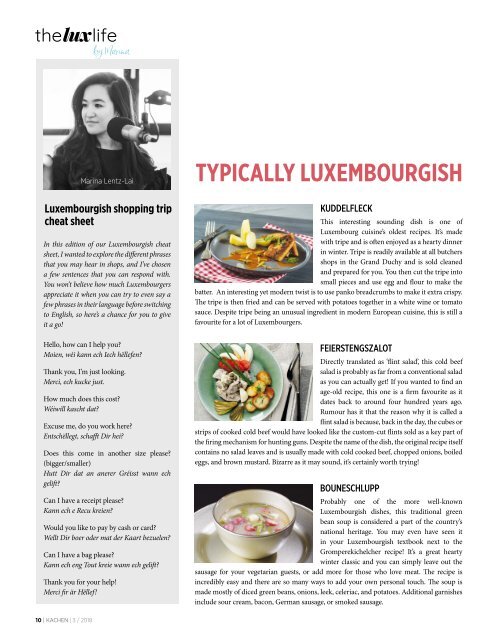KACHEN #16 (Autumn 2018) English edition
- No tags were found...
Create successful ePaper yourself
Turn your PDF publications into a flip-book with our unique Google optimized e-Paper software.
Marina Lentz-Lai<br />
TYPICALLY LUXEMBOURGISH<br />
Luxembourgish shopping trip<br />
cheat sheet<br />
In this <strong>edition</strong> of our Luxembourgish cheat<br />
sheet, I wanted to explore the different phrases<br />
that you may hear in shops, and I’ve chosen<br />
a few sentences that you can respond with.<br />
You won’t believe how much Luxembourgers<br />
appreciate it when you can try to even say a<br />
few phrases in their language before switching<br />
to <strong>English</strong>, so here’s a chance for you to give<br />
it a go!<br />
Hello, how can I help you?<br />
Moien, wéi kann ech Iech hëllefen?<br />
Thank you, I’m just looking.<br />
Merci, ech kucke just.<br />
How much does this cost?<br />
Wéiwill kascht dat?<br />
Excuse me, do you work here?<br />
Entschëllegt, schafft Dir hei?<br />
Does this come in another size please?<br />
(bigger/smaller)<br />
Hutt Dir dat an anerer Gréisst wann ech<br />
gelift?<br />
Can I have a receipt please?<br />
Kann ech e Recu kreien?<br />
Would you like to pay by cash or card?<br />
Wellt Dir boer oder mat der Kaart bezuelen?<br />
Can I have a bag please?<br />
Kann ech eng Tout kreie wann ech gelift?<br />
Thank you for your help!<br />
Merci fir är Hëllef!<br />
KUDDELFLECK<br />
This interesting sounding dish is one of<br />
Luxembourg cuisine’s oldest recipes. It’s made<br />
with tripe and is often enjoyed as a hearty dinner<br />
in winter. Tripe is readily available at all butchers<br />
shops in the Grand Duchy and is sold cleaned<br />
and prepared for you. You then cut the tripe into<br />
small pieces and use egg and flour to make the<br />
batter. An interesting yet modern twist is to use panko breadcrumbs to make it extra crispy.<br />
The tripe is then fried and can be served with potatoes together in a white wine or tomato<br />
sauce. Despite tripe being an unusual ingredient in modern European cuisine, this is still a<br />
favourite for a lot of Luxembourgers.<br />
FEIERSTENGSZALOT<br />
Directly translated as ‘flint salad’, this cold beef<br />
salad is probably as far from a conventional salad<br />
as you can actually get! If you wanted to find an<br />
age-old recipe, this one is a firm favourite as it<br />
dates back to around four hundred years ago.<br />
Rumour has it that the reason why it is called a<br />
flint salad is because, back in the day, the cubes or<br />
strips of cooked cold beef would have looked like the custom-cut flints sold as a key part of<br />
the firing mechanism for hunting guns. Despite the name of the dish, the original recipe itself<br />
contains no salad leaves and is usually made with cold cooked beef, chopped onions, boiled<br />
eggs, and brown mustard. Bizarre as it may sound, it’s certainly worth trying!<br />
BOUNESCHLUPP<br />
Probably one of the more well-known<br />
Luxembourgish dishes, this traditional green<br />
bean soup is considered a part of the country’s<br />
national heritage. You may even have seen it<br />
in your Luxembourgish textbook next to the<br />
Gromperekichelcher recipe! It’s a great hearty<br />
winter classic and you can simply leave out the<br />
sausage for your vegetarian guests, or add more for those who love meat. The recipe is<br />
incredibly easy and there are so many ways to add your own personal touch. The soup is<br />
made mostly of diced green beans, onions, leek, celeriac, and potatoes. Additional garnishes<br />
include sour cream, bacon, German sausage, or smoked sausage.<br />
10 | <strong>KACHEN</strong> | 3 / <strong>2018</strong>


















